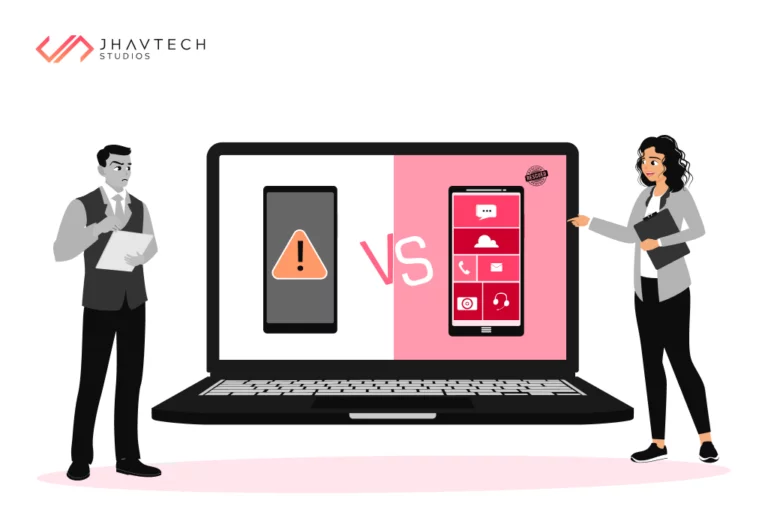Introduction
App development is a complex process that involves multiple stages and requires meticulous planning and diligent execution. It involves creative design, technical skills, and efficient project management. It is a lucrative venture, but the battle for consumers’ attention has become so intense in an already competitive sector, as more and more businesses embark on app development projects.
In order to compete, you must build a user-friendly app to attract users, solve their problems, or simply give them fun and excitement. However, you will have to overcome challenges that can impede progress and hinder success. In this blog post, we will take a close look at some of the most common app development challenges and provide tips and strategies on how to overcome them.
Understanding Common App Development Challenges
In order to successfully resolve app development challenges, it’s imperative to have a clear understanding of the difficulties that you may encounter at various stages of the development process. Let’s explore some of the most prevalent roadblocks:
- Poor Requirements Gathering: Ambiguous requirements often lead to misunderstandings and subsequent delays in the development process. Having poor requirements can add thousands of dollars in costs, cause major schedule overruns, or even require software project rescue. This highlights how serious the problem of poor requirements can be. In fact, technical experts claim that roughly 50% of app defects originate from the requirements.
Conducting thorough research and having a comprehensive list of requirements for your app will help prevent this issue and will also make it easier for you to choose an app development company to work with. By thoroughly gathering the requirements, the developers or software project rescue team can plan better and boost the chances of success. - Scope Creep: This is also known as requirements creep and it typically occurs when developers start adding new features to the project, without getting approval from the client or project management team. Expanding the project scope beyond the original set of requirements can strain resources, adversely affect timelines, and jeopardize project success.
In order to avoid scope creep, you must clearly define the goals, deliverables, and boundaries of the project. Remember that without a clear understanding of the project scope, it will be difficult to determine what’s within the boundaries of the project and what’s not.
- Inadequate Resource Allocation: Resources are a significant investment that’s why most businesses strive to maximise their use for profitability and sustainability. Whether it be funding, technology or human capital, any insufficiency can impede progress and compromise the overall quality of the final product. Improper resource allocation delays delivery, blows up costs, and ultimately derails mobile and web app development projects off their tracks.
In relation to this, the Project Management Institute conducted a pulse survey which revealed that 49% of projects cannot adhere to deadlines and 43% spike the budget. The study also showed that only 26% of organizations utilise resource management for adequate allocation of resources.The findings underscore the significance of resource allocation as it allows you to prepare and plan for proper project implementation. It helps schedule resources in advance and achieve optimum utilization. It can also help in achieving the best outcome, even with existing resource constraints.
- Lack of Communication: In today’s advanced workplace environment, gaffes and glitches still happen due to the lack of communication. This only proves how important communication is for developers to prevent problems and avoid the need to conduct a software project rescue.
Poor communication among stakeholders, development teams, and end users can lead to misaligned expectations, delays, and disappointing outcomes. On the other hand, effective communication allows every member of the team to provide updates about project changes and progress. Everyone has a chance to explain what they have been working on and any issues they have encountered. The team members can also express their ideas and suggestions to improve the project.
Communication is fundamentally important to the success of app development projects – and yet it’s something that a lot of people struggle with. Here are some tips on how to fix poor communication issues:- Limit the number of communication channels. While there are lots of useful collaboration tools in the market (e.g. Skype, Slack, Clickup, Microsoft Teams), information spread across multiple channels is difficult to keep track of. It is also hard for team members to monitor different channels and stay on top of all the details while concentrating on their primary job. Just pick one or two channels and stick with them.
- Familiarisation with jargon terms. Miscommunication between clients and app developers can occur if the former does not understand technical terms, like jargon in the app development industry. Although it’s tough to be familiar with all the technical terms, it would be great if clients learn developer terms so both parties can converse clearly
- Take time to answer or return calls. It’s crucial for app developers to be professional and considerate when communicating with clients and colleagues. Take calls or return those that you have missed. Make it a habit to schedule calls with key people to update them about project status.
- Refrain from calling for a meeting unless it’s very important. One may argue that more meetings translate to better communication, but think of how often you realise that a meeting failed to produce the desired result. So, before scheduling a meeting, consider if the agenda can be discussed via email or perhaps through a simple 5-minute chat during a coffee break. In a nutshell, ask yourself if you can effectively pass on information in a short message and save people’s time instead of dragging them into a meeting room.
- Technical Roadblocks: These refer to unexpected technical challenges that can impede the development process and require extra time and effort to resolve. Common examples include launching the app on multiple platforms, leaving security issues unattended, inadequate testing, and getting rejected by the app stores.

Overcoming App Development Challenges
The stiff competition among businesses has made mobile, web and desktop app development more challenging than ever. Hence, technical experts experiment with app development projects and often lag once they encounter hurdles and difficulties. But while such challenges are inevitable, you can take proactive steps to successfully develop a responsive and user-friendly app.
Let’s take a close look into strategies and best practices to turn roadblocks into stepping stones towards success:
1. Comprehensive Requirements Gathering
Requirements gathering or requirements elicitation involves exploring user personas, identifying key stakeholders, conducting user research, and determining the fundamental requirements of the project. It is critical to ensure that the app being built meets the needs of the end users and delivers business value.
As such, it is imperative to invest time and effort, in ensuring clarity among stakeholders. You’ll need to conduct interviews, workshops, and surveys to gather insights from all parties involved. The process ends in documenting the requirements while considering functionality, user experience, and any potential constraints.
Beyond the obvious advantages of having the right set of requirements with which to work, comprehensive requirements gathering offers the following benefits:
- This improves the chances that clients and users will get what they expect. Stakeholders often find it difficult to put into words exactly what they need. Hence, you’ll have to help them and this entails some digging.
- Minimises the risk of a failed project.
- Reduces the total cost of the project by identifying requirements issues before development starts.
2. Agile Development Approach
The agile project management approach is an iterative app development methodology. It helps organize planning and designing, development, and testing methods during an app’s lifecycle. It will help you divide the project into sprints while focusing on delivering incremental releases. In turn, this will enable you to engage stakeholders regularly to seek feedback, allowing for adjustments and avoiding scope creep.
There are different agile development methodologies, but we recommend Scrum or Kanban for enhanced adaptability and flexibility. Scrum works best for app development projects with unclear outcomes, meaning the project evolves as it progresses. You can therefore expect a lot of improvements and the result will only become clearer when the project is nearing completion.
On the other hand, Kanban is perfect if you want transparency throughout the development process. You can break the project down into workflows and monitor progress by tracking a specific task’s stage. Kanban will allow you to set limits for ongoing work, so you can control the number of tasks that your team is working on at any given time. This will help you optimize resources so no resource is at risk of burnout.
3. Resource Planning and Allocation
Pursuing your app development project with dedicated resources is a must. Be sure to conduct a comprehensive evaluation of resource requirements at every stage of the process. Ensure that you have enough team members and equip each one with the necessary tools to get the job done. Aside from checking the availability of the team members, you must also scrutinize the app budget and come up with a blueprint to effectively distribute it through the various development and planning stages. Lastly, monitor resource utilization and make the necessary adjustments to maintain efficiency. These steps will help you avoid delays and complete crucial tasks within stipulated timelines.
4. Effective Communication Channels
Right from the start, it’s vital to establish clear and open lines of communication among stakeholders, members of the development team, and the end-users. Effective communication ensures that everyone is on the same page and all requirements are well-understood. It also provides for timely feedback and issue resolution, thereby contributing to the successful delivery of high-quality web and mobile applications.
In most instances, poor communication is the cause of project failure. In order to avoid this, schedule meetings and conduct regular progress reviews to ensure everyone stays aligned and informed. In addition, maximise collaboration tools and project management platforms to facilitate task tracking and seamless exchange of information.
A recent study revealed that 79% of people who use a project management tool to communicate with their co-workers say it leads to improved internal communication; 73% claim it leads to enhanced efficiency; 62% say it results in increased rate of project success; 41% say it delivers better customer experience; and 27% relate it to better employee wellbeing.

Testing and Quality Assurance
To ensure the success of app development projects, testing and quality assurance play a pivotal role. When done correctly, you can catch bugs and glitches before your app hits the market, resulting in a smoother user experience.
1. Comprehensive Testing Strategies
Conduct thorough testing at every stage of the development process to identify and rectify issues early on. This can be done by implementing well-defined testing strategies including functionality tests, cross-platform tests, usability tests, performance tests, regression tests, and security tests.
It would be great if you could automate the aforementioned testing processes to increase efficiency and reliability. Remember that behind each successful app is effective testing that can help address the challenges that may crop up at any stage of the development process.
2. User-Centric Testing
User testing involves individuals using the app to determine how they interact with it. It is a type of usability testing and is arguably the most important because it provides the most precise information on how users will react to your web or mobile app.
A user-centric test means the focus is on the target users and their experience, not on the app itself. This helps in gathering user feedback and validating your app’s usability. You can then iterate and improve your app based on user feedback.

Conclusion
Challenges encountered in app development projects are common, but they can be effectively overcome with proper planning, seamless communication, the right strategies, and a mindset. By having a clear understanding of the common challenges like poor requirements gathering, scope creep, inadequate resource allocation, lack of communication, and technical roadblocks, you can implement proactive measures to navigate such obstacles and negate the need for software project rescue.
It is important to note that challenges represent opportunities for growth and improvement. Face them head-on, learn from them, and use them to propel your app development journey. With sheer dedication, hard work, and the right support, you can turn roadblocks into stepping stones towards success.
.svg)













